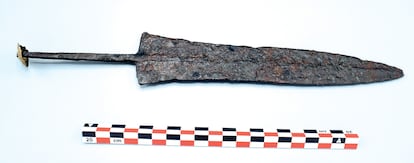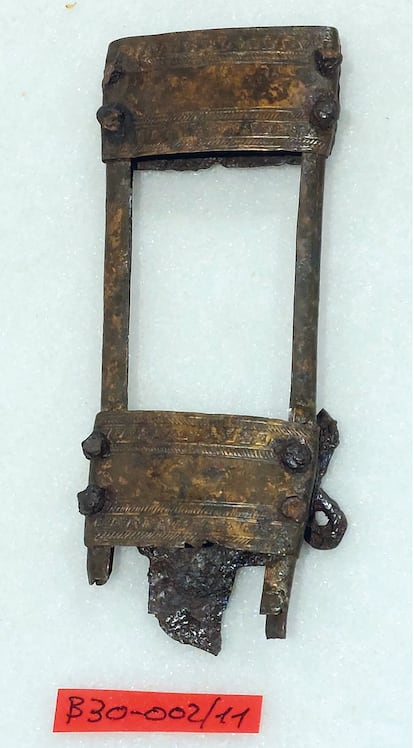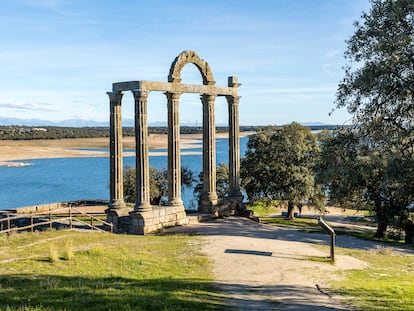The unsolvable mystery of Hannibal’s soldier
Widespread looting of archaeological sites has prevented experts from determining if a unique Vacceai dagger belonged to an Iberian warrior who brought it home from the battlefield in the third century BC


In 2001, Spain’s Civil Guard launched Operation Tambora to locate and seize an incredible trove of 108,670 archaeological pieces looted from sites in the southern provinces of Seville, Córdoba and Jaén. All the pieces came from two properties belonging to Ricardo Marsal. Four years later, the regional government of Andalusia reluctantly took charge of the relics and created the Ricardo Marsal Monzón Archaeological Fund (FARRM).
Nearly two decades later, the work to analyze and organize the collection continues. Fernando Quesada Sanz, a professor of archaeology from the Autonomous University of Madrid recently published a study about the origins of the Vacceai dagger and the problem of identifying the provenance of relics in many collections. Quesada bitterly laments that experts will never be able to substantiate the story of an Iberian warrior in Hannibal’s army who was wounded in battle and returned home with all his armaments, including a valuable dagger, to die in his village of Espelúy (Jaén, Spain).
The rampant looting that the Civil Guard dismantled over 20 years ago during 102 investigations has made it impossible to know for sure whether the dagger that Hannibal’s solider carried almost 280 miles (450 kilometers) from the Duero River valley in central Spain to Andalusia in the south is a one-of-a-kind piece or just another of the hundred-plus such daggers that have been unearthed.
The dagger is on exhibit in the Iberian Museum in Jaén, and is catalogued by the institution as “coming from the Iberian necropolis of La Carada,” and discovered by “illicit looting activity.” It was made by the Vaccaei, a pre-Roman Celtic people of Spain who inhabited the Northern Plateau region, sometime in the final 30 years of the third century BC. More than a hundred examples of this type of dagger have been found in the Duero River basin and surrounding areas. This one measures 12 inches (30.5 centimeters) in length, and 1.77 inches (4.5 centimeters) at its widest. The handle is made of a copper alloy, while the scabbard is made of iron (only about 60% of the scabbard remains intact). Quesada said, “This piece could be an extraordinarily unusual version of a third century BC weapon called the tang-sheathed dagger. The pistiliform [tongue-shaped] blade is an absolute rarity for this type of dagger.”
If the dagger was actually discovered in Jaén, Quesada said “it would be a unique finding due to its distance from where the weapons were made in the Northern Plateau and Cantabria in the north.” Confirmation that the dagger was actually unearthed in Jaén would link it directly to the military campaign led by Hannibal, the Carthaginian general, against the Vacceai in 221-220 BC. It would mean that one of Hannibal’s soldiers returned to his village with the dagger after the battles.
But because there is no irrefutable evidence that it was found in Espelúy, only a note written by Marsal that was seized by the Civil Guard, Quesada said, “There is doubt [about the provenance], which is an excellent example of the problems caused by the illicit trade in relics. So instead of having an important archaeological find, we are left with vague speculation.”

Quesada said, “This weapon is a perfect example of the problems caused by removing pieces from context, pulled out of the ground without applying reliable archaeological methods or documentation. In fact, it could be just another specimen of a well-studied type of dagger, or an exceptionally interesting and meaningful weapon because of where it was found. We know that the FARRM collection mostly consists of pieces from Andalusia, and that the original owner of the collection, or recovery fund as he liked to call it, was very diligent about documenting the provenance of even the smallest objects. Before buying anything, he demanded very detailed data from the sellers [looters], including site sketches and even drawings of where grave relics were placed in tombs. But we can imagine that the sellers sometimes provided inaccurate or completely invented data. There is no way of ever being completely sure.”
According to Quesada, the most plausible hypothesis is that the weapon ended up in an Andalusian tomb after one of the Iberian soldiers in Hannibal’s army returned home. But there are three other possibilities. One is that it was manufactured in the second century or early first century BC, and that its design was copied or modified by the Iberians from Celtiberian and Vacceai models. Another possibility is that it was plunder owned by a legionnaire of the Roman Republic who traveled down to Jaén from the north. Lastly, the weapon could have been looted in the 1970s or 1980s from a site in the Northern Plateau and sold to Ricardo Marsal in Andalusia.

Ricardo Marsal was called “El boinas” (The beret guy) by relic looters. According to Ariane Capdevila Sanz of the University of Barcelona, who authored a 2019 study on archaeological site plundering, Marsal “was a collector who for over 30 years in the late 20th century, acquired coins and objects using a metal detector... He was an organized person who classified and studied the pieces in his workshop, and created notecards to identify each object that later helped [the Civil Guard and archaeologists] to understand the sites where they were found. The collection consisted of numismatic material, ceramic objects, architectural pieces, sculpture, epigraphs and stelae, among others. The time periods of the pieces ranged from prehistoric to contemporary times, traversing protohistory, Roman, late Roman, medieval and modern times.”
Capdevila writes, “The collector/plunderer went to the National Archaeological Museum, probably hoping to prevent the collection from leaving Andalusia. In 2005, the regional government of Andalusia legalized the collection and documentation when it was donated by Marsal, and it became the Ricardo Marsal Monzón Archaeological Fund. An official statement was issued thanking him for his contributions to the enrichment of Andalusian heritage.” There were no criminal repercussions because the entire collection was looted prior to Spain’s 1985 Heritage Law.
For professor Quesada, the dagger represents an opportunity to contemplate how the dagger can either be an important new discovery or just another piece like hundreds of others. “The lack of trustworthy information about the provenance of this particular weapon robs us of the opportunity to conduct a reliable historical analysis. I would be hard-pressed to find a better example of the destruction of relevant information due to an irregular excavation, to put it mildly.”
Sign up for our weekly newsletter to get more English-language news coverage from EL PAÍS USA Edition
Tu suscripción se está usando en otro dispositivo
¿Quieres añadir otro usuario a tu suscripción?
Si continúas leyendo en este dispositivo, no se podrá leer en el otro.
FlechaTu suscripción se está usando en otro dispositivo y solo puedes acceder a EL PAÍS desde un dispositivo a la vez.
Si quieres compartir tu cuenta, cambia tu suscripción a la modalidad Premium, así podrás añadir otro usuario. Cada uno accederá con su propia cuenta de email, lo que os permitirá personalizar vuestra experiencia en EL PAÍS.
¿Tienes una suscripción de empresa? Accede aquí para contratar más cuentas.
En el caso de no saber quién está usando tu cuenta, te recomendamos cambiar tu contraseña aquí.
Si decides continuar compartiendo tu cuenta, este mensaje se mostrará en tu dispositivo y en el de la otra persona que está usando tu cuenta de forma indefinida, afectando a tu experiencia de lectura. Puedes consultar aquí los términos y condiciones de la suscripción digital.
More information
Archived In
Últimas noticias
Most viewed
- Sinaloa Cartel war is taking its toll on Los Chapitos
- Oona Chaplin: ‘I told James Cameron that I was living in a treehouse and starting a permaculture project with a friend’
- Reinhard Genzel, Nobel laureate in physics: ‘One-minute videos will never give you the truth’
- Why the price of coffee has skyrocketed: from Brazilian plantations to specialty coffee houses
- Silver prices are going crazy: This is what’s fueling the rally










































